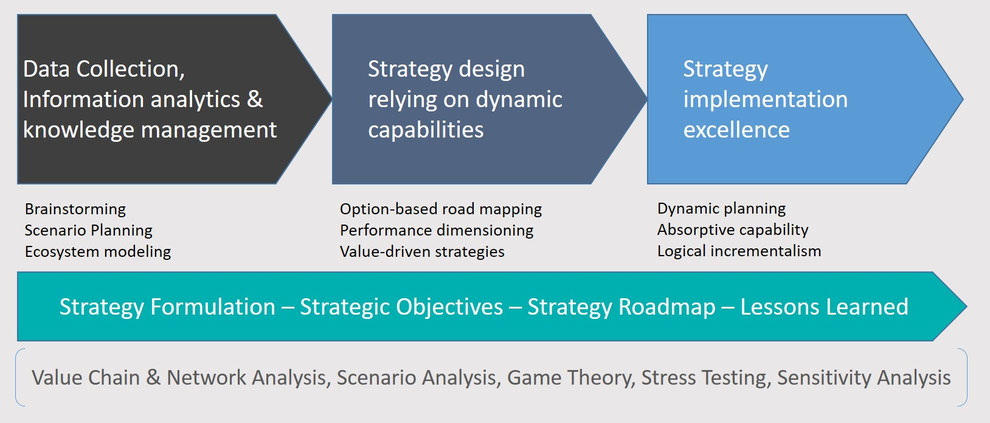TOPICS: Strategy Design | Corporate & Business Strategy | Competitive Strategies | Corporate Development
The VUCA World

We help you navigate VUCA times: today's business environment is characterised by Volatility, Uncertainty, Complexity and Ambiguity - often referred to as the "VUCA world" - a combination of factors that can exacerbate the effects of external disruption on an organisation's operating model:

Historic management practices are based on stability, calculable risk, and a simple- best practices- environment. “Agile”, strategic characteristics such as, road-maps and minimum viable product, complemented by individual capabilities and scenarios, can help you and your organisation to execute processes and projects in a mix of volatility, uncertainty, complexity and ambiguity.
However, there will be an element of luck in your journey to find the right blend of agile, uncertainty management capabilities, scenario planning with traditional leadership, management and execution approaches.
Consequently, in times of organisational change, dealing with ambiguity is a critical new leadership skill. Business leaders shall realise the breakthrough success in transformation requires not only forward-thinking strategies but also a transformation of the company's underlying functions and organisations, in order to build the new sets of business capabilities to adapt to the "VUCA" normality .
VUCA Tools
The VUCA world requires a revision of how your business collect and analyse information, make strategic decisions, develop plans and implement them. There is not one single tool that equips leaders for VUCA readiness: it is a combination of tools to be used along the life-cycle of your readiness process.

Data collection and analytics: VUCA world requires consideration of greater amount of factors and expansion of the planning horizon. As a result, there’s a growing popularity of forecasting methods, which can be united under the concept of foresight. Foresight is different from the traditional predictive models called forecasting. While forecasting is based on the forward projection of past experiences. Foresight includes more advanced methods of anticipation logic which allow making possible scenarios based on weak signals, emerging trends, coexisting presents and potential paths of evolution. Strategic foresight is especially useful in situations that are characterised as a VUCA context.
Designing a strategy, is the most subjective one and in many schemes is depicted simply as a black box. This is a stage when the strategy itself is created. In most cases, it is a plan of initiatives based on a chain of goals. At this stage, strategists may face many challenges: treating the symptom vs. sorting around, making false assumptions, making a false shot a short frame, lacking buy-in etc.There are even more problems in the conditions of the VUCA World. Understanding your dynamic capabilities, modelling your strategy alignment and applying value-driven strategies are fundamentals elements to build a robust strategy road-map.
The critical factor for both the strategy design stage and the next stage of strategy implementation is the gap between strategy and execution when “the plan remains the plan”. One of the modern methods of solving above-mentioned problems is a dynamic strategic plan which should be continually refined and improved. Studies on the application of dynamic planning principles evidence an increase in the accuracy of forecast fulfilment and improvement in company productivity: 40% greater average customer profit margin, 29% improvement accuracy of actual revenue to budgeting revenue. The most complete application of dynamic planning principles can be achieved with the help of such strategic management tool as road mapping.
Zoom-in: Absorptive Capacity
Absorptive capacity conceptualises an organisation's ability to utilise external knowledge through a sequential learning process that use existing internal organisational knowledge to recognise the value of external knowledge, assimilate this new knowledge through exploratory learning and apply this knowledge to create new knowledge and value.
Early research into absorptive capacity focused on learning and innovation with respect to the performance of the firm and the firm's ability to acquire, assimilate and apply external knowledge. Absorptive capacity is dependent on an organisation existing knowledge, but it is a dynamic capability, taking an integrative system thinking view of absorptive capacity and organisational learning as learning processes
Organisations must continually explore the VUCA environment, gaining situational understanding to sense and seize on opportunities and threats. Traditionally, in stable environments, organisations relied on experience, routines, learning and scale but volatility evident in the new VUCA environment is driving organisations to engage with stakeholders across external boundaries, drawing them into the learning and innovation process.
As well, organisations should shift paradigms from continuous improvement and instead focus on adaptability by being proactive in learning new knowledge to innovate and make better decisions. Similarly, organisational learning is an incremental accumulation of individual stakeholders’ absorptive capacities to learn, as well as the organisations direct communication structures to the external and internal environments of the organisation.
